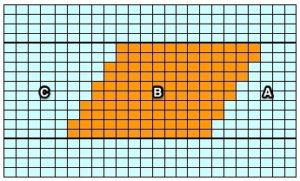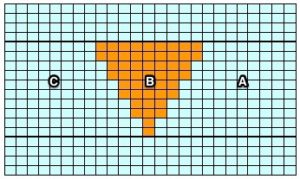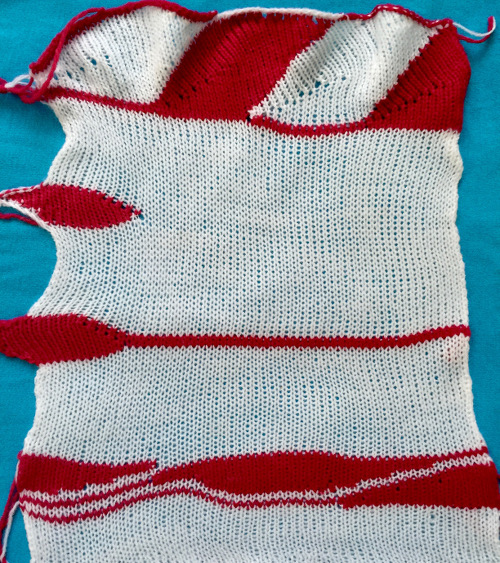Picture knitting/intarsia may at times be achieved using holding techniques. As in any such knitting, supplies include extras such as bobbins, clothespins, or weighted clips, but no separate carriage. If the ribber is in use and one is working on a large piece, ribber covers allow the yarns to hang in front of the ribber bed.
Some of the rules for accomplishing this using short rows: it is helpful to work from a chart. Two-row sequences are required, so having the working chart double-length makes the process easier to visualize. “Follow” knitting directions with any tool to determine that the pattern is executable, with no long floats or slits.
The bottom of any diagonal line is always knit first.
Needles are brought out to hold on the carriage side, and pushed back into work opposite the carriage; one exception to this rule is if “automatic wrapping” is used. In the latter one, fewer needles are brought into hold than needed opposite the carriage, the row is knit, then with the carriage on the alternate side the first needle in hold next to stitches just knit is brought out to hold, resulting in a “wrap” and correcting the count to the desired number. Any number of needles may be pushed back into work at any time. More than single stitches brought to hold on the carriage side will produce floats.
When knitting shapes the only needles in work are those being worked to create that shape.
Base rows of knitting, whether in waste yarn or as part of the pattern, are needed prior to working in the holding position.
Remember that you are working on the purl side, so any image will be flipped horizontally on the knit side. Reverse the chart horizontally before working it if direction matters.
Begin with a simple shape. Letters indicate the knitting sequence for short-rowed sections. Patterning in these charts begins with COR, bold lines separate areas of plain knitting, letters indicate the order for executing short row segments. The fabric produced lies flat, with no noticeable 3D protrusions.
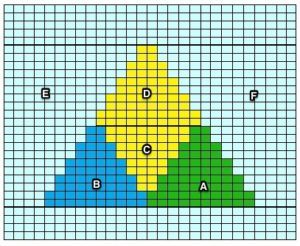 marking sequences with numbers is easier for me to follow; color changes help define segments, but do not reflect final colors in the design
marking sequences with numbers is easier for me to follow; color changes help define segments, but do not reflect final colors in the design 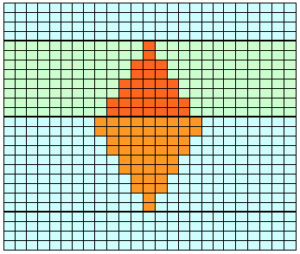
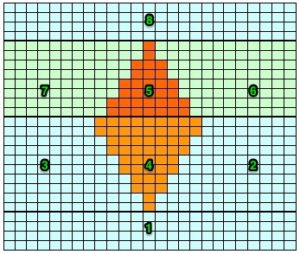 a supermini swatch: holes are typical both in intarsia and in short rows if no wrapping occurs
a supermini swatch: holes are typical both in intarsia and in short rows if no wrapping occurs 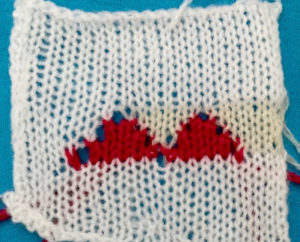 be prepared to weave in a lot of yarn ends
be prepared to weave in a lot of yarn ends  going larger, note the wider “steps” created
going larger, note the wider “steps” created 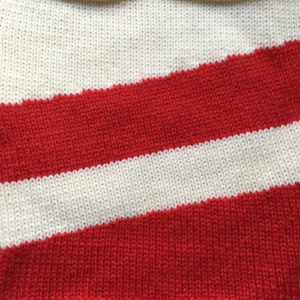

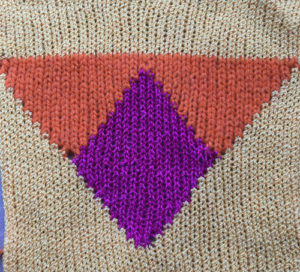 more complex geometry: line drawing on “graph paper”
more complex geometry: line drawing on “graph paper”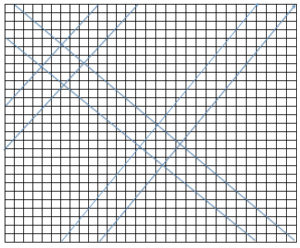 the start of color placement
the start of color placement 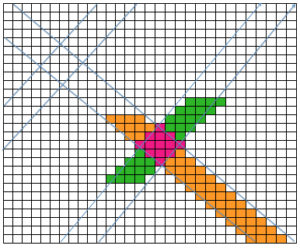 sequence for executing segments at the completion of the design
sequence for executing segments at the completion of the design  in actual knitting the pattern must be elongated X2
in actual knitting the pattern must be elongated X2
I find it helpful to use familiar yarn and to work variations of a familiar shape prior to taking on more complex patterns. Below is a cousin of the first shape illustrated in this post, with a pattern worked beginning COL, repeated across the row, increments in the number of stitches worked in short rows but mirrored on both shape sides (shown in the first swatch segment).
 filling in to produce a flat fabric, with straight sides: the bottom segment
filling in to produce a flat fabric, with straight sides: the bottom segment 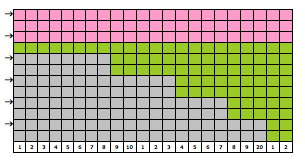 the top segment
the top segment  the amended chart
the amended chart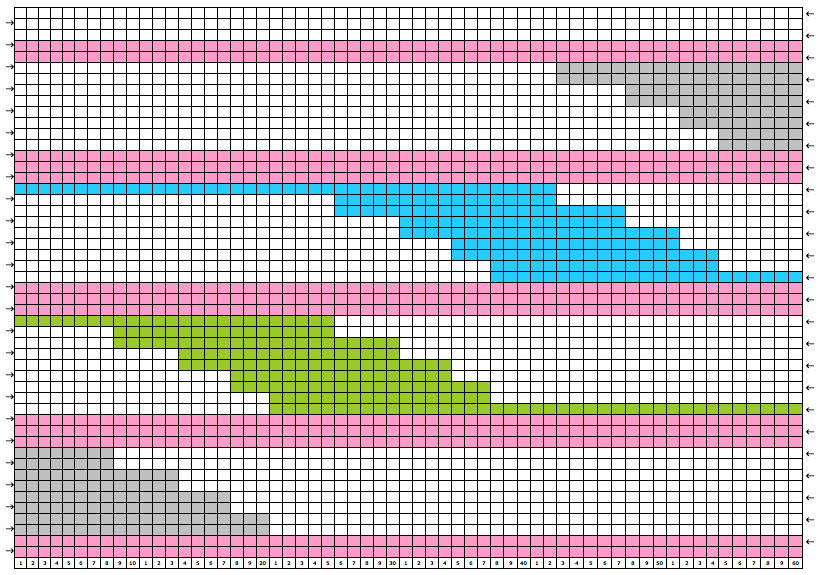
Some of the same shapes may be placed on a shaped edge. The repeat will likely need some editing; arrows indicate the direction of knitting for that row. If the background color is used for casting on and binding off, then the isolated shape floats on the ground, and the horizontal line of contrast color is eliminated.

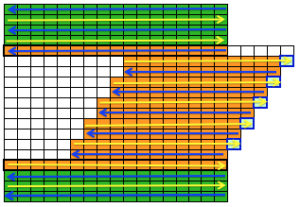 creating an outline of shape with Color 1
creating an outline of shape with Color 1![]()
 horizontal rotation to achieve “leaf” shape
horizontal rotation to achieve “leaf” shape 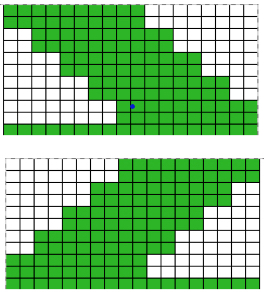 melding shapes
melding shapes  don’t like wrapping? for smaller holes offset the return to work position upper half of the shape by one less needle at the start, added at the end.
don’t like wrapping? for smaller holes offset the return to work position upper half of the shape by one less needle at the start, added at the end.
A first look at knitting direction  and at stacking shapes, with bound-off stitches
and at stacking shapes, with bound-off stitches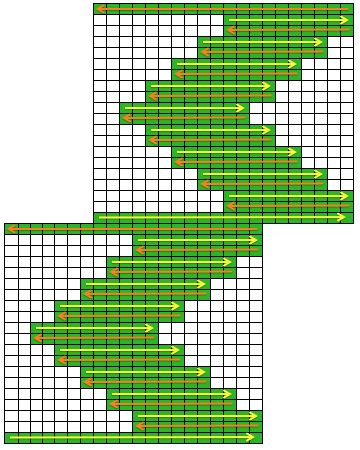
 The start of a smooth shaping sequence for those “leaf shapes” on the machine
The start of a smooth shaping sequence for those “leaf shapes” on the machine
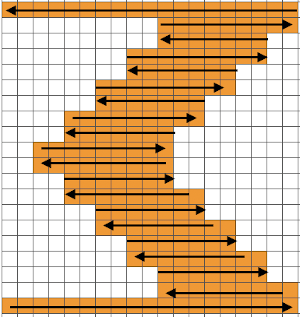
The yarn used is acrylic, so pressing helps to make the shapes lie flat. Once again, using wool or any other yarn with “memory” will result in considerable curl at the side and at the top and bottom of the knit piece, so that is a consideration in putting in the effort. The more striping, the more yarn ends to weave in and row counts to watch. Using space-dyed or sock yarns may produce pleasing though unplanned stripe patterns in any of the shapes. My samples are not resolved final fabrics. There are many inspiring patterns available for purchase or at times free on the internet for hand knitting, usually in garter stitch as well as holding, resulting in a nearly square gauge, flat-lying knit.
Taking it to garments: accessories are easiest, since the gauge may not be significant. Shawl shapes in HK are often knit on circular needles, without the constraint of the fixed number of needles on any particular model KM. Sometimes, with adjustments, the same shapes may be rotated sideways on the KM. Segment sizes may differ due to the resulting change in gauge. Sampling techniques and shapes in smaller versions help work out the kinks.
Sources for inspiration: large-scale shapes
http://www.garnstudio.com/pattern.php?id=7365&cid=17
http://www.garnstudio.com/pattern.php?id=7543&cid=17
http://www.garnstudio.com/pattern.php?id=7375&cid=17
http://www.garnstudio.com/pattern.php?id=7099&cid=17
http://www.garnstudio.com/pattern.php?id=6729&cid=17
http://www.garnstudio.com/pattern.php?id=6333&cid=17
http://www.garnstudio.com/pattern.php?id=6001&cid=17
more details, varying concentration, and placement: free pattern
http://www.garnstudio.com/pattern.php?id=7606&cid=17
for purchase on Ravelry
http://www.ravelry.com/patterns/library/endless-rainbow
http://www.ravelry.com/patterns/library/rigoles
http://www.ravelry.com/patterns/library/dreambird-kal
http://www.ravelry.com/patterns/library/scarf-with-flames
http://www.ravelry.com/patterns/library/phoenix-wing—phoenix-flugel
http://www.ravelry.com/patterns/library/spring-plumage
http://www.ravelry.com/patterns/library/hundertwasser-neptunia
http://www.ravelry.com/patterns/library/swingtrelac
